Let’s talk about the mouthwatering world of Indian desserts and why they are an essential part of Indian cuisine. Indian desserts hold a special place in the hearts and taste buds of the people here. They are not just sweet treats but a reflection of our vibrant culture and culinary heritage.
When you visit India, you simply cannot miss out on trying our delightful array of desserts. Each region has its own unique specialty. From the syrupy goodness of Gulab Jamun in the north to the creamy decadence of Payasam in the south. These desserts are not only scrumptious but also offer a glimpse into the diverse flavors and traditions of the country.
People in India prepare during festivals, weddings, and other celebrations, making them an integral part of our social and cultural gatherings. They craft them with love and passion. And they also use a wide range of ingredients like aromatic spices, ghee (clarified butter), nuts, and exotic fruits.
Traditional Indian Desserts
Traditional Indian desserts are a delightful reflection of the country’s culinary heritage and time-honored recipes. Gulab Jamun, with its soft and syrup-soaked dumplings, captures the essence of indulgence. Kheer, a creamy rice pudding flavored with aromatic spices, offers comfort in every spoonful. Jalebi entices with its crispy spirals and sticky sweetness. And Barfi, a fudge-like confectionery, comes in a myriad of flavors, each offering a rich and creamy experience. These traditional desserts people enjoy for generations. Their flavors and textures continue to captivate taste buds and bring joy to celebrations and everyday moments.
Gulab Jamun
Gulab Jamun is one of the most beloved and iconic Indian desserts. These soft, syrup-soaked dumplings are a true indulgence for anyone with a sweet tooth. Made from a mixture of khoya (reduced milk solids), flour, and a hint of cardamom, Gulab Jamun is deep-fried until golden brown. It has a deliciously rich and caramelized exterior. The dumplings are then soaked in a fragrant sugar syrup infused with rose water and sometimes saffron, which adds an aromatic touch to the dessert. The result is a heavenly combination of flavors and textures that melt in your mouth.
Gulab Jamun is not only a dessert but also a symbol of celebration and festivity in Indian culture. You can find them during weddings, festivals like Diwali and Eid, and other special occasions. The name “Gulab Jamun” is from the Persian words “gulab,” meaning rosewater, and “jamun,” referring to a fruit resembling the shape of the dessert. This dessert has become a staple in Indian cuisine.
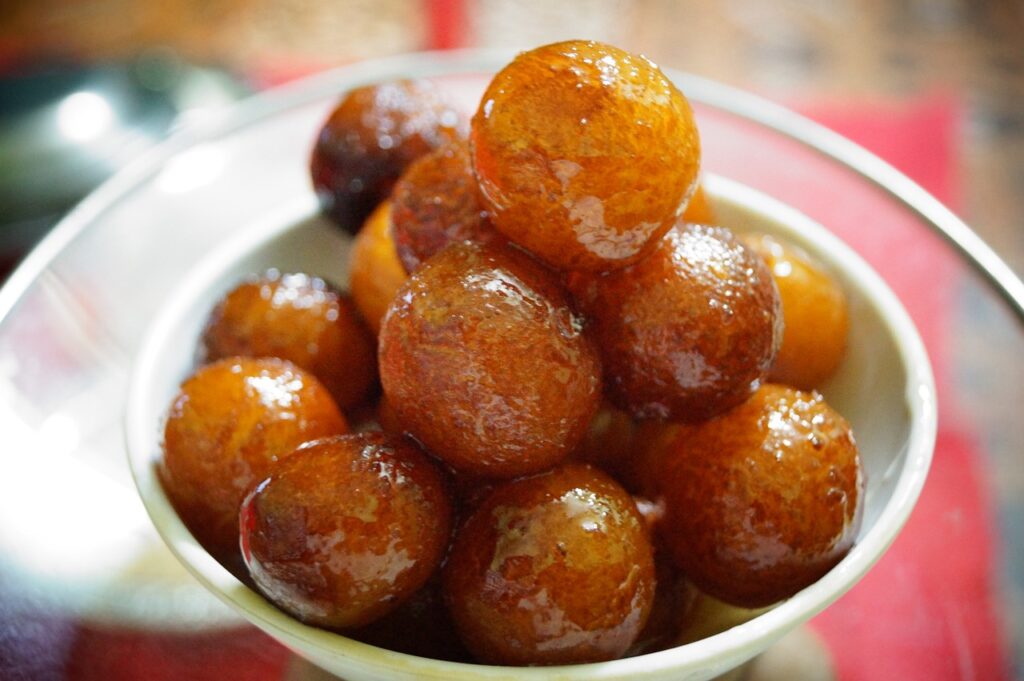
Jalebi
Jalebi is a popular Indian dessert that people love for its unique spiral shape, vibrant orange color, and irresistible sweetness. Made from a fermented batter of all-purpose flour and yogurt, Jalebi is deep-fried until crispy and then soaked in a fragrant sugar syrup. The batter is carefully piped into hot oil in circular patterns, resulting in the characteristic spiral shape that gives Jalebi its distinct appearance. Once soaked in the syrup, Jalebi becomes soft, sticky, and incredibly flavorful. It often has garnish with crushed pistachios or saffron strands for an extra touch of elegance.
People enjoy jalebi across India, and it holds a special place in festivals and celebrations. You will find it during festive occasions like Diwali and Ramadan, as well as weddings and other joyous events. Jalebi you can eat as a dessert or as a popular street food snack, especially when paired with a warm cup of masala chai. The combination of its crispy texture, the syrup’s sweetness, and the slight tanginess from the fermentation process creates a delightful contrast of flavors that makes Jalebi a beloved treat for many.
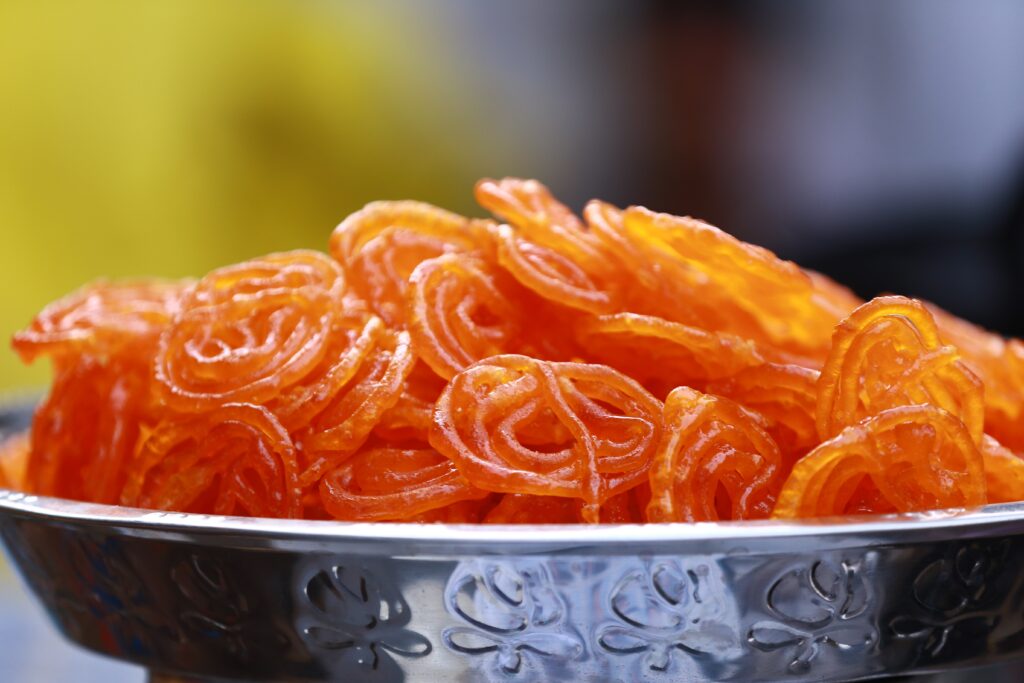
Kheer (Rice Pudding)
Kheer, also known as Rice Pudding, is a creamy and indulgent dessert that holds a special place in Indian cuisine. It is made by slow-cooking rice in milk, sweetened with sugar or condensed milk. And flavored with aromatic ingredients like cardamom, saffron, and rose water. The rice absorbs the richness of the milk, resulting in a velvety texture and a delicate balance of flavors. You can have kheer warm or chill. And often has garnish with nuts, such as almonds or pistachios, to add a delightful crunch.
Kheer is not only a delicious dessert but also a significant part of Indian traditions and celebrations. It is common during festivals, religious ceremonies, and special occasions as a symbol of prosperity and auspiciousness. In fact, you can find mentions of Kheer in ancient Indian scriptures, and people believe it to be a favorite of the deities. Whether you enjoy it as a comforting dessert on a cozy evening or as a centerpiece of a festive feast, Kheer continues to captivate taste buds with its creamy texture and delightful flavors.
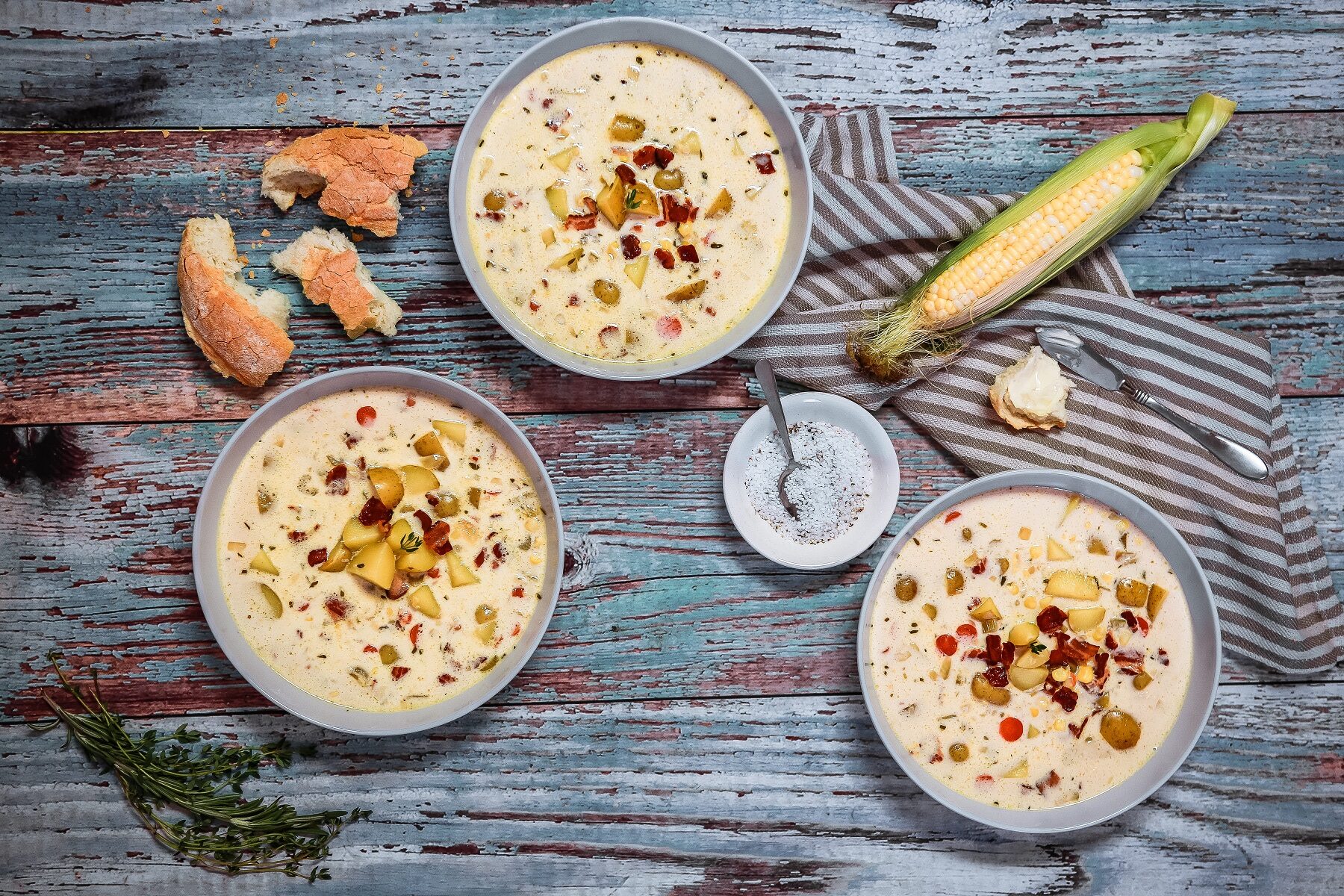
Barfi
Barfi is a delectable Indian sweet that has gained popularity both in India and around the world. It is a fudge-like confectionery from condensed milk, sugar, and a variety of flavors and additions. The base ingredients are cooked together until they thicken and solidify, resulting in a dense and creamy texture. Barfi comes in a wide range of flavors, including cardamom, pistachio, coconut, almond, and rose. It often has garnish with chopped nuts or edible silver foil, adding a touch of elegance to its appearance.
Barfi holds a special place in Indian cuisine. People in India prepare it during festivals like Diwali, Raksha Bandhan, and Eid, as well as during celebrations and special occasions. The name “Barfi” is from the Persian word “barf,” meaning snow, which is fitting given the smooth and snowy appearance of the sweet. Its melt-in-your-mouth texture and irresistible flavors make Barfi a favorite among both young and old. Also, people will share it as a gift or serve as a dessert to celebrate joyous moments with loved ones.
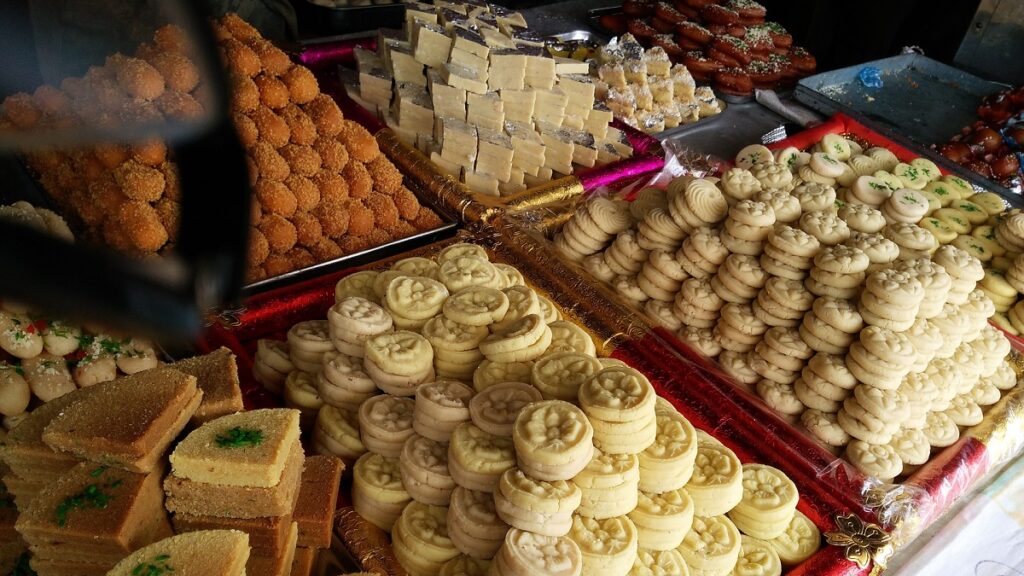
Regional Indian Desserts
Regional Indian desserts offer a delightful exploration of the diverse culinary landscape across the country. From the syrup-soaked Rasgulla of Bengal to the aromatic Modak of Maharashtra, each region boasts its own unique sweet specialties. In the southern state of Karnataka, the melt-in-your-mouth Mysore Pak, made with ghee, sugar, and gram flour, is a beloved treat. Andhra Pradesh offers the delicate and crispy Pootharekulu, also known as paper sweets, made with rice flour and jaggery. These regional desserts showcase the distinct flavors, ingredients, and techniques that contribute to the vibrant tapestry of Indian cuisine.
Rasgulla (Bengali Sweet)
Rasgulla is a popular Bengali sweet that has gained recognition and popularity throughout India and beyond. These soft and spongy cheese balls are made by kneading chenna (freshly made cottage cheese) and semolina together, which are then shaped into small spheres and cooked in a light syrup made of sugar and water. The result is a delightful sweet delicacy that is both melt-in-your-mouth and subtly sweet. Rasgulla is chilled, allowing the syrup to infuse into the cheese balls and create a refreshing and delightful dessert.
Rasgulla holds a special place in Bengali cuisine. People will enjoy it during festivals, celebrations, and special occasions, adding a touch of sweetness to the festivities. The art of making Rasgulla requires precision and skill. The simplicity of its ingredients and the perfect balance of sweetness make Rasgulla a beloved treat. It has won the hearts of sweet lovers worldwide.
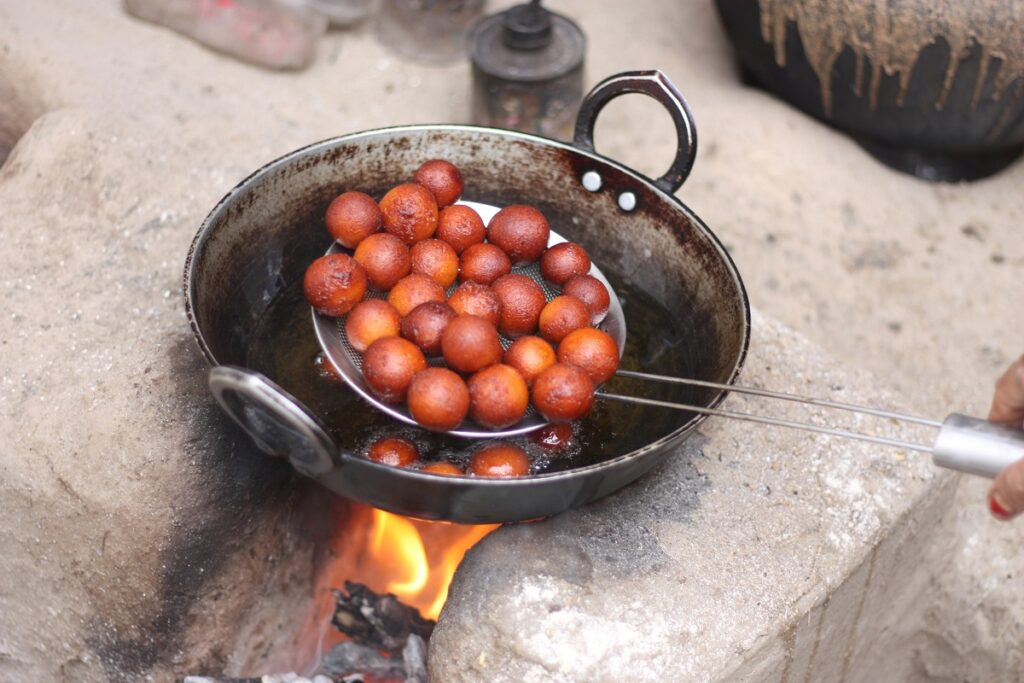
Mysore Pak (Karnataka Sweet)
Mysore Pak is a delectable sweet originating from the state of Karnataka, India. The chickpea flour is roasted in ghee until it reaches a golden brown color, giving it a rich and nutty flavor. The roasted flour is then mixed with hot ghee and sugar syrup, resulting in a dense and fudgy texture. Mysore Pak is often cut into square or diamond-shaped pieces and is famous for its melt-in-your-mouth goodness. It is a staple sweet during festivals and special occasions in Karnataka and people love it for its indulgent taste.
Mysore Pak has a history dating back to the royal kitchens of Mysore, where it was created in the 19th century. The dessert was originally for the royal family and was popular for its luxurious texture and taste. Over time, Mysore Pak became a popular sweet across the state of Karnataka.
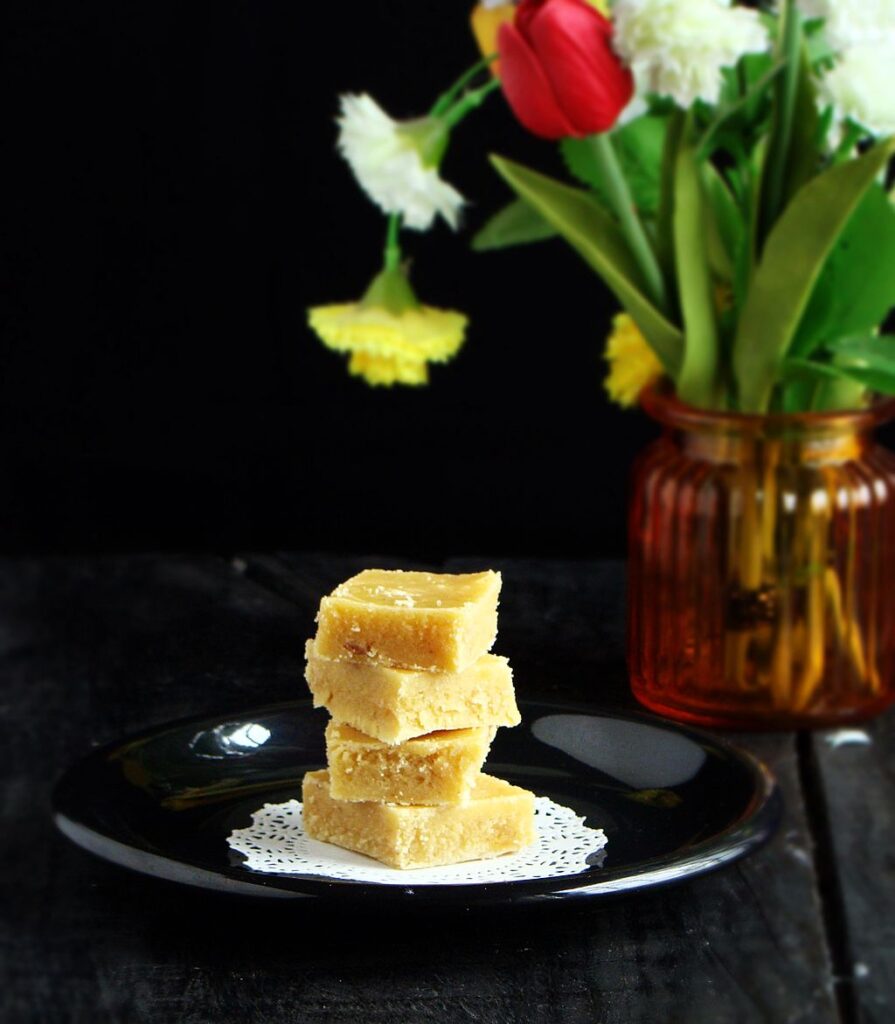
Modak (Maharashtrian Sweet)
Modak is a traditional Maharashtrian sweet that holds immense cultural significance, particularly during the auspicious festival of Ganesh Chaturthi. These sweet dumplings are made from rice flour or wheat flour dough that is filled with a mixture of jaggery (unrefined cane sugar), grated coconut, and aromatic spices such as cardamom and nutmeg. The dumplings are then steamed or fried until they acquire a soft and delectable texture. Modak often comes in a shape like a small, inverted pyramid, resembling Lord Ganesha’s favorite sweet treat.
People love modak not only for its delightful taste but also revered for its association with Lord Ganesha, the Hindu deity of wisdom and prosperity. It is an offering and a symbol of good luck and blessings. The process of making Modak is seen as a sacred ritual. Often it will be passed down through generations and enjoyed as a shared activity during the festive season.
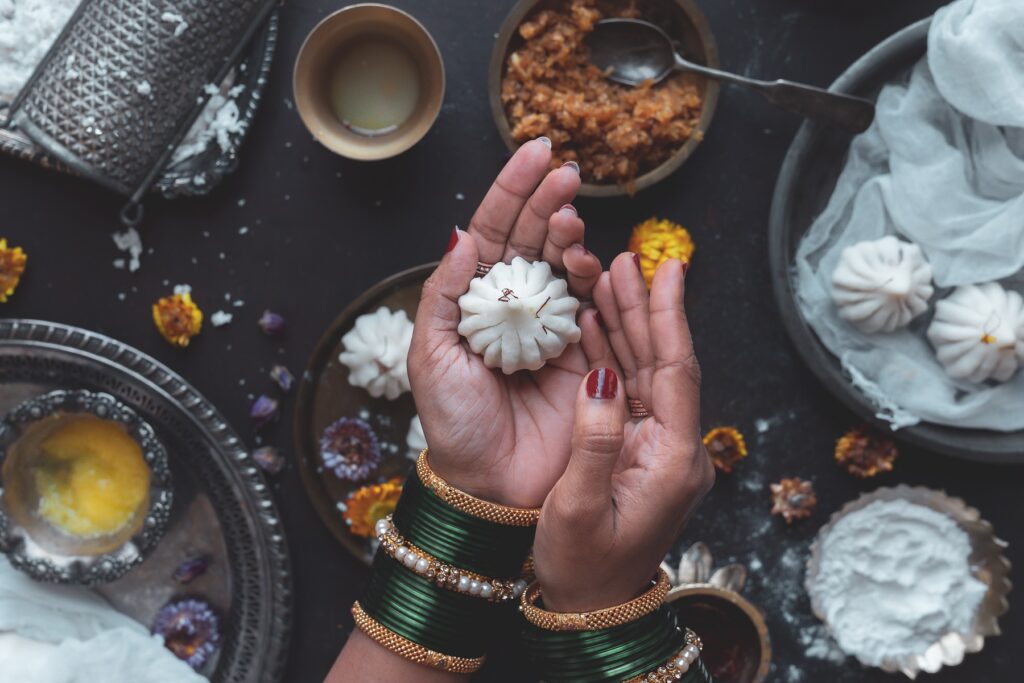
Pootharekulu (Andhra Pradesh Sweet)
Pootharekulu, also known as “Paper Sweets,” is a traditional sweet delicacy from the state of Andhra Pradesh, India. It is made by rolling a thin layer of rice flour batter into a paper-thin sheet and filling it with a mixture of jaggery (unrefined cane sugar), ghee (clarified butter), and cardamom powder. The delicate rice sheet is then carefully folded into a cone shape, creating a visually appealing and texturally unique sweet. Pootharekulu has a crispy and brittle texture that shatters with each bite, revealing the sweet and aromatic filling. It symbolizes the rich culinary heritage of Andhra Pradesh.
Pootharekulu is not just a delicious sweet treat but also an art form. The skill required to make the thin rice sheets without tearing them and the precision in folding them into the desired shape is a testament to the craftsmanship involved. The flavors of jaggery and cardamom blend harmoniously, providing a delightful balance of sweetness and spiciness.
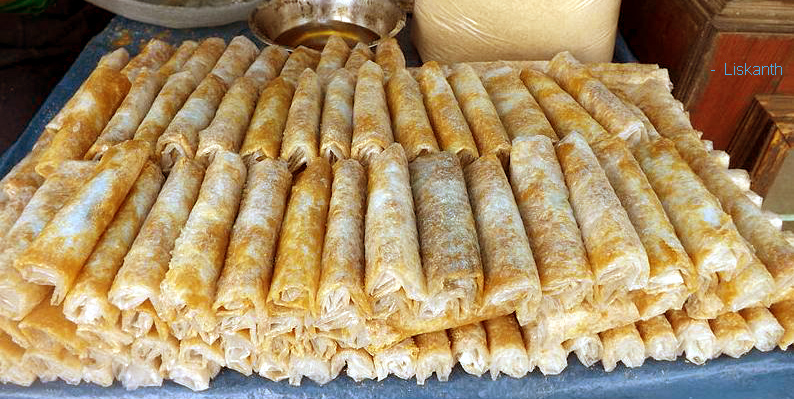
Fusion and Modern Indian Desserts
Fusion and modern Indian desserts represent an exciting and innovative twist on traditional sweets. They combine traditional Indian flavors and techniques with contemporary culinary concepts, resulting in unique and delightful creations. These desserts often incorporate global ingredients and culinary influences. From Rasmalai Cheesecake to Chai-flavored Macarons, fusion, and modern Indian desserts showcase the creativity and versatility of Indian cuisine, offering a new and exciting way to experience the rich and diverse world of Indian sweets.
Rasmalai Cheesecake
It is a delightful fusion dessert that combines the flavors of two beloved Indian sweets: Rasmalai and cheesecake. Rasmalai, a popular Bengali sweet, consists of soft paneer (Indian cottage cheese) dumplings soaked in creamy and aromatic milk syrup. The cheesecake version takes this indulgence to the next level. By incorporating the essence of Rasmalai into a creamy cheesecake filling with a biscuit crust. The result is a luscious dessert that beautifully combines the rich, creamy texture of cheesecake with the delicate flavors of Rasmalai. It’s a heavenly treat that brings together the best of both worlds.
This fusion dessert has gained popularity for its unique and luxurious taste. Whether enjoyed on special occasions or as a decadent treat, Rasmalai Cheesecake offers a delightful twist on traditional desserts.
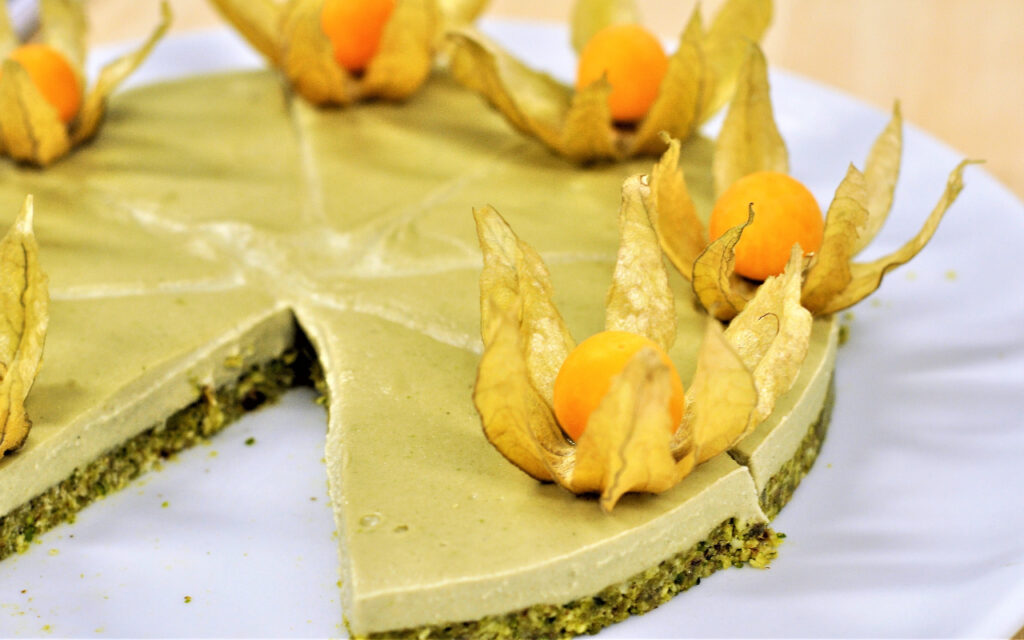
Gajar Halwa (Carrot Halwa) Ice Cream
Gajar Halwa, also popular as Carrot Halwa, is an Indian dessert made with grated carrots, milk, sugar, and a hint of cardamom. It is a rich and indulgent sweet treat that is you can often enjoy during festivals and special occasions. Gajar Halwa Ice Cream takes this classic dessert to a whole new level. By incorporating its flavors into a refreshing frozen delight. The creamy ice cream base is infused with the essence of Gajar Halwa. It creates a delightful combination of creamy texture and the natural sweetness and subtle spiciness of carrots. It’s a unique twist on a traditional dessert that offers a cool and refreshing way to enjoy the flavors of Gajar Halwa.
The fusion of traditional Indian flavors with the cold, creamy goodness of ice cream results in a dessert that is both familiar and exciting. Gajar Halwa Ice Cream offers a delightful marriage of flavors and textures.
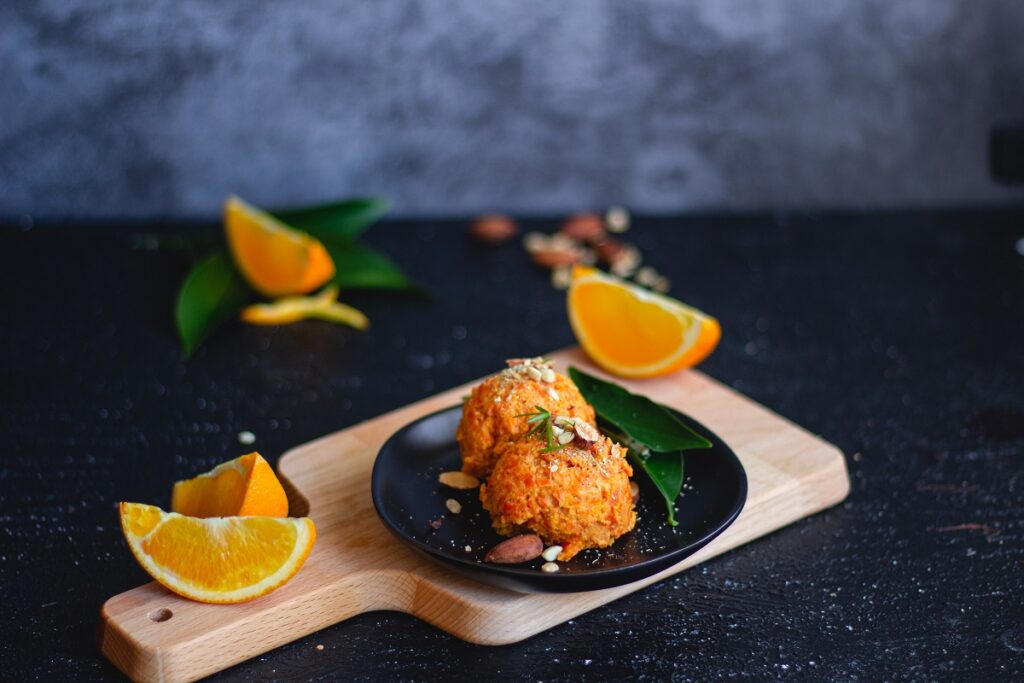
Mango Kulfi
Mango Kulfi is a delectable frozen dessert that has its roots in Indian cuisine. It is a creamy and indulgent treat made with the luscious sweetness of ripe mangoes, milk, sugar, and cardamom. Unlike traditional ice cream, Mango Kulfi has a denser and richer texture. It is achieved by slowly simmering the milk until it reduces and thickens. The addition of fresh mango puree adds a burst of tropical flavor that beautifully complements the creamy base. Mango Kulfi is often served in small, individual molds or in traditional clay pots, known as matkas, and garnished with chopped nuts for an extra crunch.
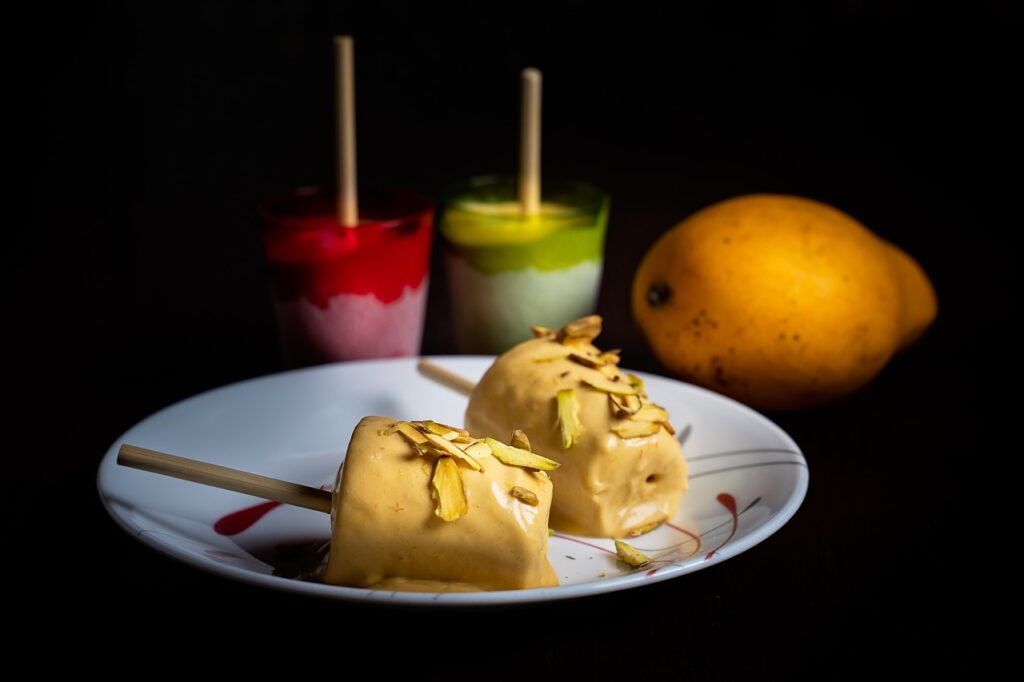
Mango Kulfi holds a special place in Indian summers, providing a refreshing and cooling dessert to beat the heat. It captures the essence of the beloved fruit, and it has a velvety texture and sweet, fruity taste.
Savor the flavors of India at your doorstep!
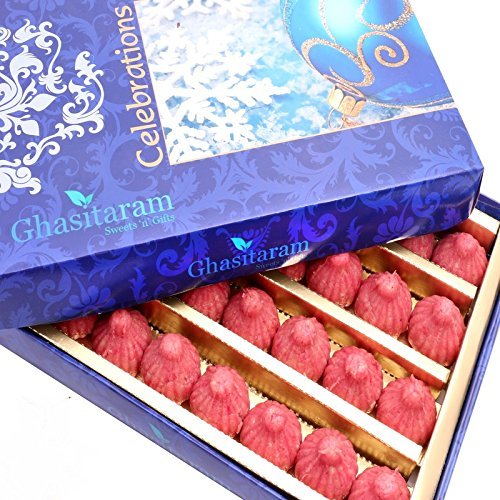
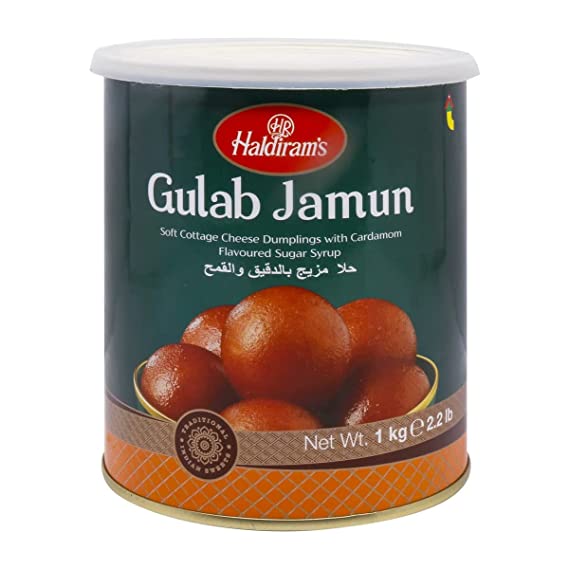
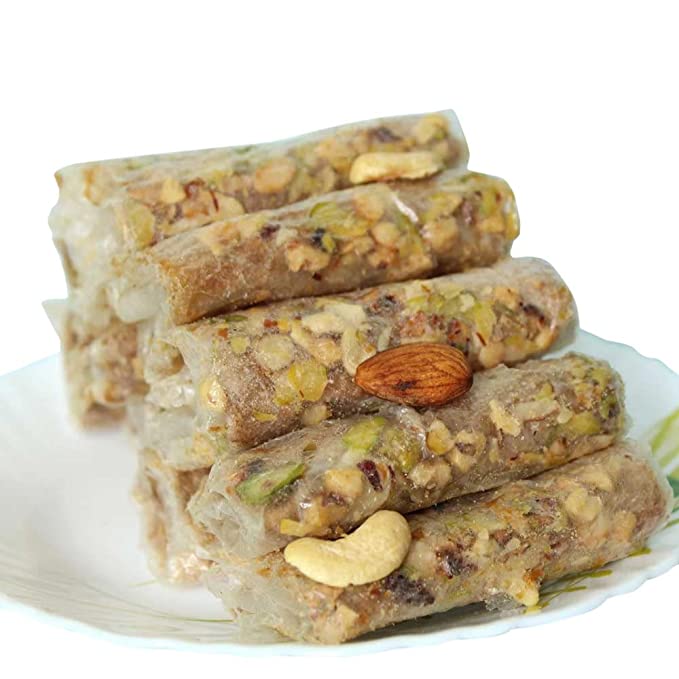
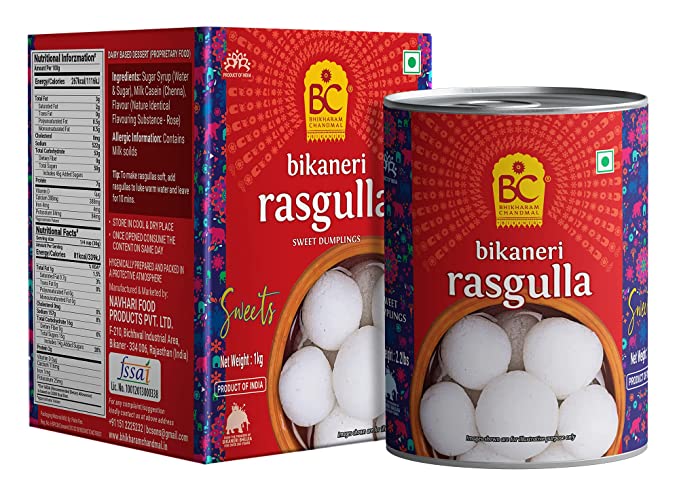
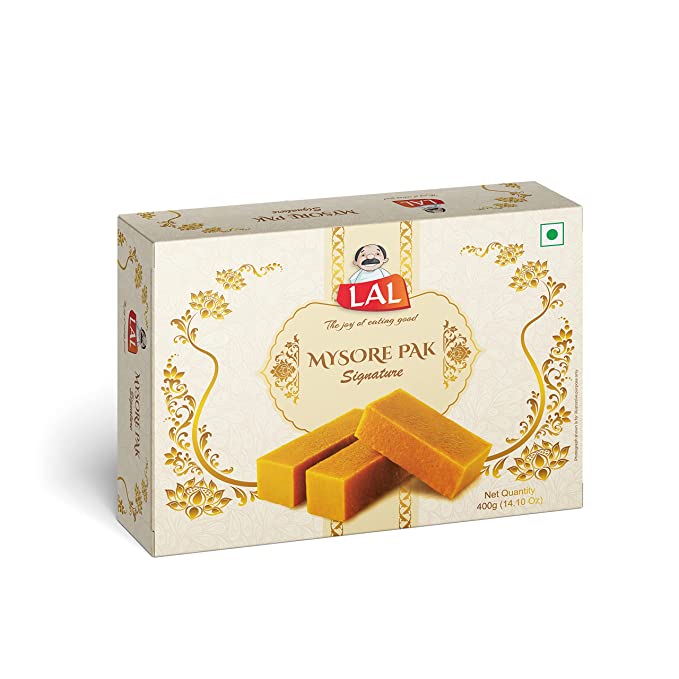
Dive into the diverse world of Indian desserts today!
Indian desserts are a treasure trove of flavors, textures, and cultural significance. From the syrup-soaked delights like Gulab Jamun and Jalebi to the creamy indulgence of Kheer and Barfi. Each dessert tells a story of tradition, celebration, and the artistry of Indian culinary heritage. The regional and traditional Indian desserts showcase the diversity of the country’s culinary landscape, with each region offering its own unique sweet creations. Furthermore, the fusion desserts like Rasmalai Cheesecake and Mango Kulfi exemplify the creative evolution of Indian sweets. They bring together traditional flavors with modern twists. Whether enjoyed during festivals, special occasions, or as a simple everyday pleasure, Indian desserts have the power to satisfy the sweet tooth and evoke a sense of joy and togetherness. Plan your trip, embark on a sweet journey, and indulge in the delectable world of Indian desserts that will leave you craving more.
